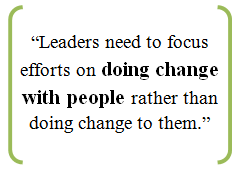Making Change Happen: Part 4 of 4
Part Four: What Do Successful Change Leaders Look Like?
To conclude our series, we bring you an article from the Journal of Applied Behavioral Science in which, taking a qualitative approach, the authors interviewed leaders from 33 organizations to identify the behaviors of successful change leaders.
Analyses of the data indicated that leader-centric behaviors have an adverse impact on change implementation. In contrast, behaviors that may be described as being more facilitating and engaging are positively related to change success. Four critical behavior sets are identified. It was evident that leaders who experienced the highest levels of success deployed all four of the behavior sets and minimal presence of leader-centric behaviors.
 Click here to read the complete article, published in the JABS September 2011 issue by Malcolm Higgs of the University of Southampton and Deborah Rowland, then of Transcend Consultancy and currently People Director at BBC Worldwide.
Click here to read the complete article, published in the JABS September 2011 issue by Malcolm Higgs of the University of Southampton and Deborah Rowland, then of Transcend Consultancy and currently People Director at BBC Worldwide.
And if you haven’t yet heard it, don’t miss the SAGE podcast with Dr. Jean Bartunek, associate editor of JABS as well as Ethics Adjudication Chair and past president of the Academy of Management, who discussed her commentary, “How Qualitative Research on Change Can Contribute to Changing Practice,” published in the JABS June 2012 special issue. Her commentary and podcast provide inspiration for practitioners to create change in the world:
A benefit of qualitative research as opposed to quantitative research is that it focuses on local perceptions and experiences of phenomena of interest. In particular, it explicates “the ways people in particular settings come to understand, account for, take action, and otherwise manage their day to day situations” (Miles & Huberman, 1994, p. 7). Qualitative research also enables researchers to gain understanding and appreciation of the dynamics associated with these phenomena (Bartunek & Seo, 2002, p. 238).





























































































